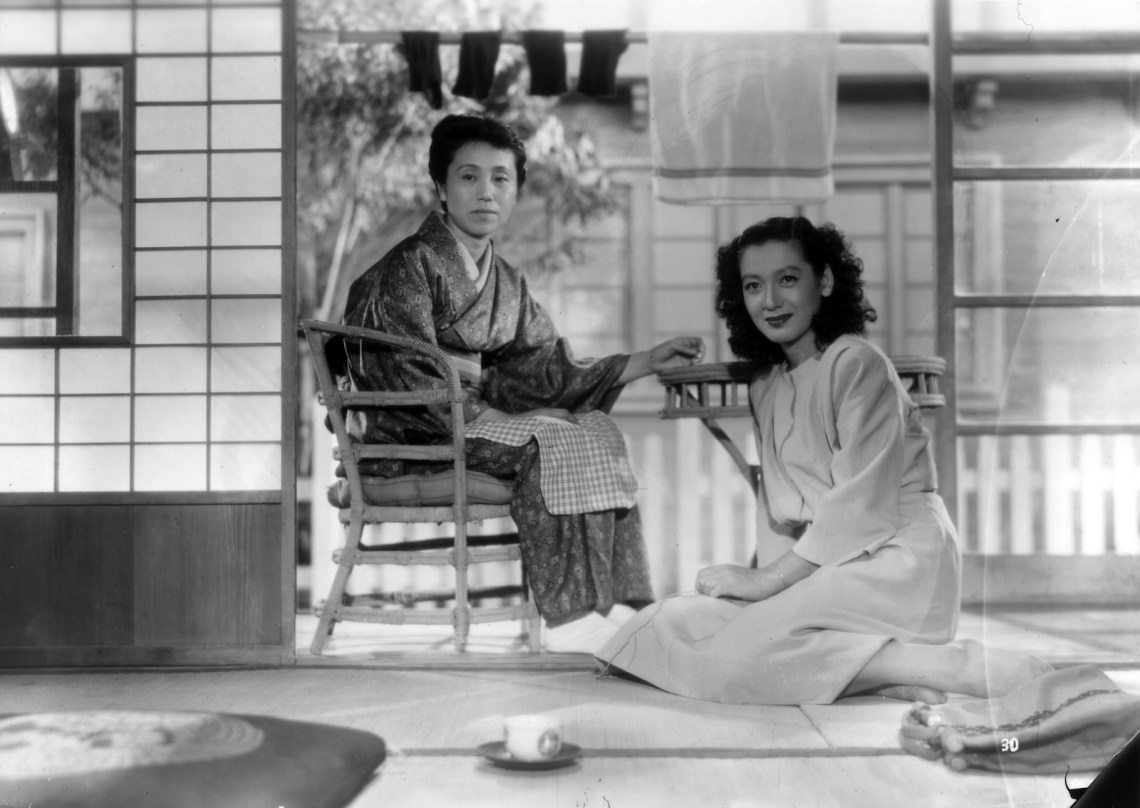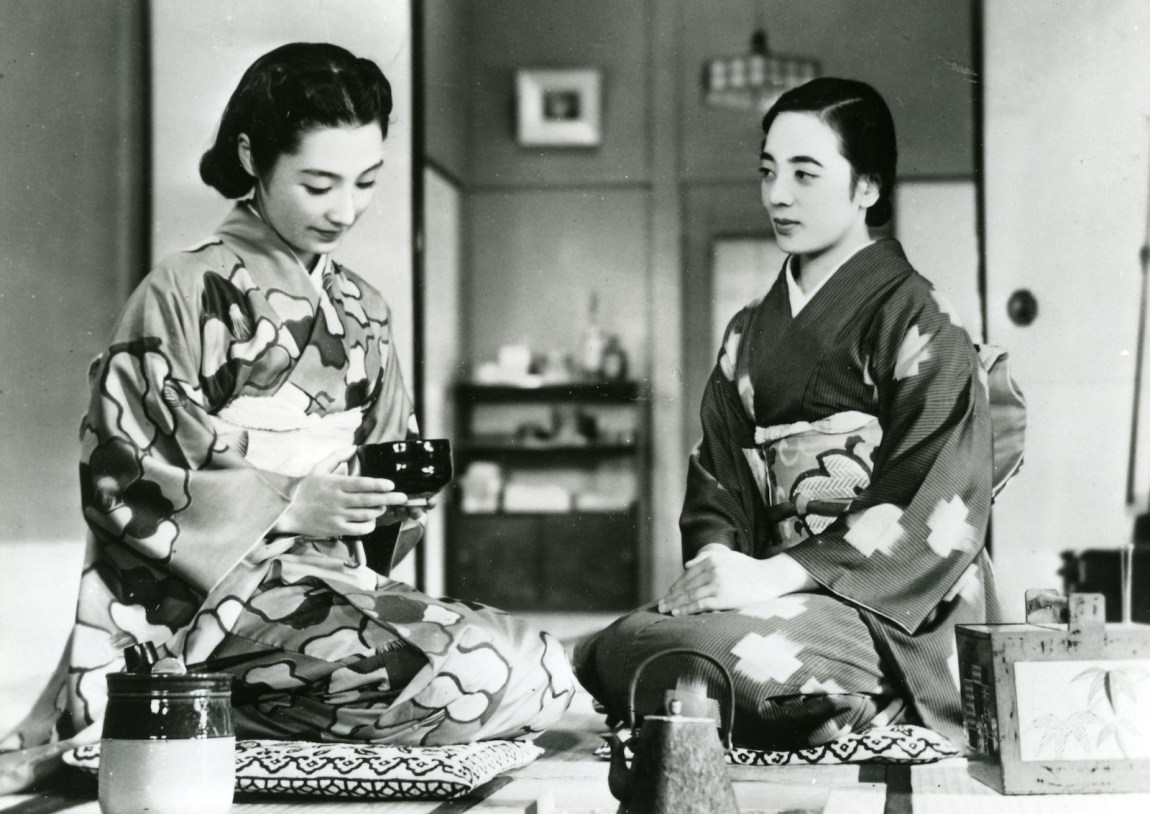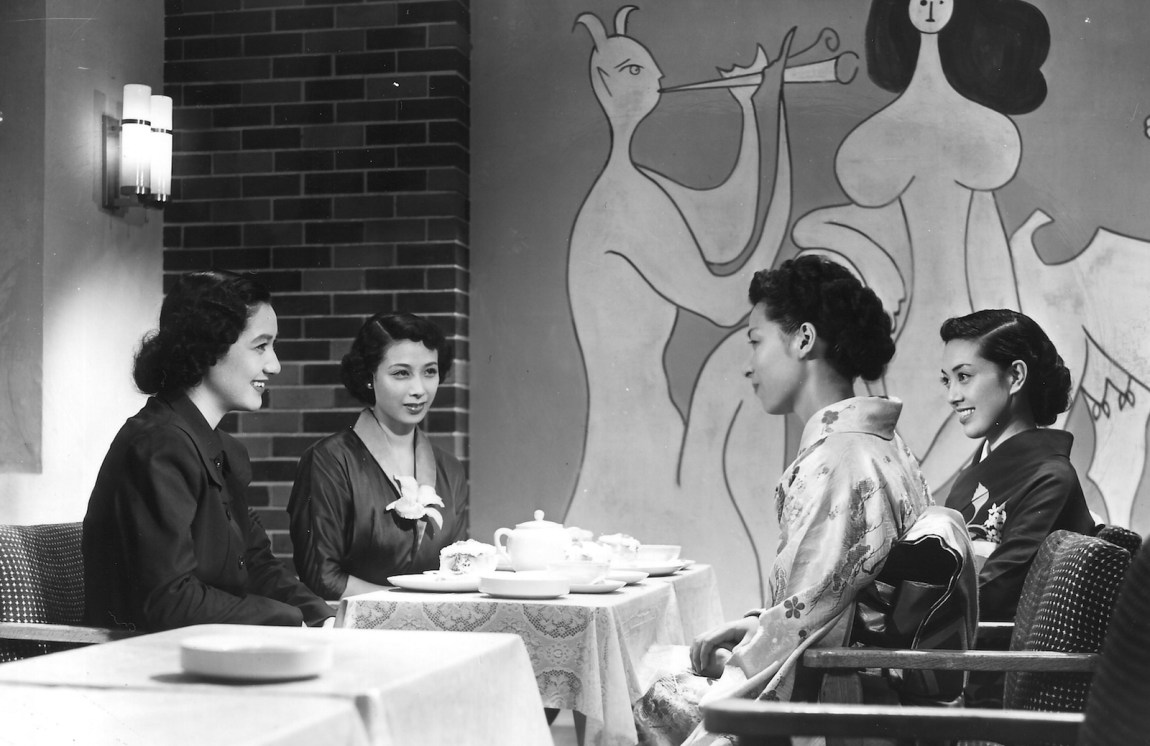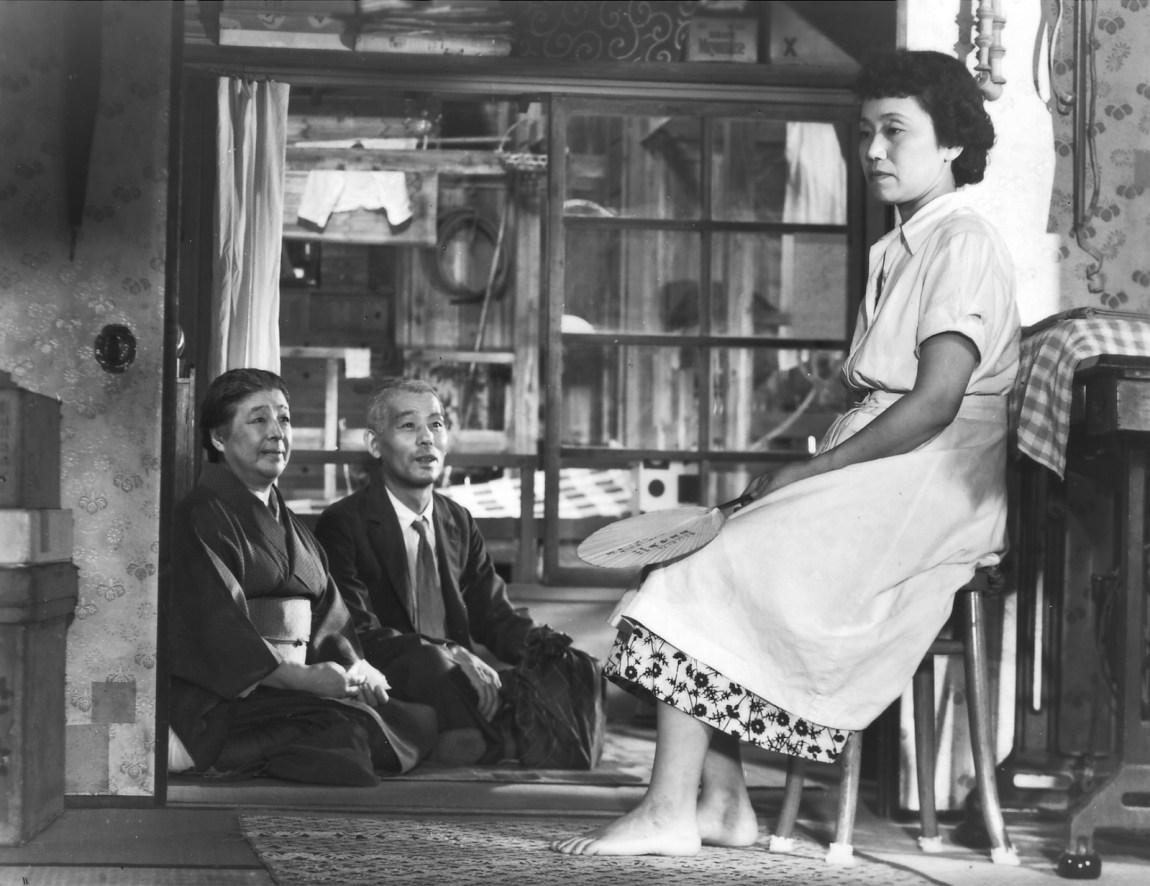Whenever there’s been a turn in my life, I’ve turned toward him. The first afternoon I got to college, worn out from a fifteen-hour flight from Tokyo, I put a light blanket over my head and watched an Ozu—Early Summer. The night I moved to Manhattan, I walked into a repertory theater downtown that was showing one of his comedies, Good Morning. The screening was sold out, so I stood in the back, alone and alight, listening to the laughter.
Yasujiro Ozu’s friends often described him like a boulder, his back surprisingly large, his manner steady, and his actresses leaned on this solidity. Growing up and watching his women—seeing them hurry, glance, and pause—I saw that he understood the need to delay before life takes over, knew the breath you must take before a new lap, before you lightly push off the wall and become a new person. Throughout my twenties I would meet girls in Boston and New York and New Haven, brunette, lofty, and a little patrician, who seemed to descend from that line of head-turning women: Katharine Hepburn, Claudette Colbert, Barbara Stanwyck. With their confident chins, their expressive arms and ankles, the characters they played seized their selves and guaranteed their happiness. But I had not grown up watching them, as these girls had with their mothers. I came from another line.
In both Early Summer (1951) and Good Morning (1959), a woman says the same thing about a daughter, back bowed, giving it the weight of the world: “She acts like she grew up all by herself.” Grew up all by herself: hear the touch of abandonment but also admonishment. There’s a certain irony to this line. There are many boys in Ozu’s films, but very few little girls.
Time and time again, we see boys undergoing an education, losing their illusions. A pair of brothers walk down a road, their heads bent heavily, absorbing what failure means. But women step lightly, already fully formed. The die has been cast, the shape of their characters is set, and they are compelled to make decisions: Should they eat a slice of cake? Where should their parents sleep? Who should they marry? Ozu’s women can be girlish, but their concerns are not of girlhood. He drew mothers and aunts and adult daughters in every shade, but how they grew up—that was left a blank.
The potential catastrophe of girlhood—awakening into sexuality, which could turn a girl into an “easy” woman—was not a prospect that Ozu contemplated, at least not onscreen. The few girls in his films are mostly toddler-sized and sick. By the time the story begins, girlhood has already passed. It is often, however, summoned in memory. When Ozu’s women get together, one inevitably starts singing a song from grade school, and her friends join in, rocking their heads and clapping their hands, thirteen again. His late films often start with a visit from a family friend, who marvels that a daughter of the house is unrecognizable, a girl no longer. As a teenager I yearned to be these pictures of humor and grace, to skip ahead to a stage of life when I, too, could reminisce selectively about my girlhood. But over the years the shadows in such moments have become more visible to me. The women arrive readymade, snappy and convenient, and the songs of their girlhoods chime like commercials for bottled water, plastic commodities sourced from pure springs.
“A wife is just another convenient tool,” a drunk, out-of-work husband says bitterly in The Munekata Sisters (1950). “Like a doorbell. Or a washboard.” The film spares this husband no mercy—he dies of a heart attack the day he gets a new job, roundly disliked—but he articulates the disquiet that the men in Ozu’s films feel about self-sufficient women. Daughters, sisters, and friends exchange knowing glances as they go about their business: smoothly overseeing their households, fetching and clearing tea without being asked, earning their keep running bars, working at the office. But having sped past girlhood to a marriageable age, they see that they run the risk of becoming just another tool, convenient to anyone—and at crucial moments, they laugh and decline. Their fathers and brothers try to reprimand them for their independence, but it doesn’t stick. From his early talkies to his late films, Ozu’s women make their resistance felt—their everyday mutinies ringing, indeed, like doorbells.
I followed these bells, these scenes of convenience, across the movies screened at Film Forum and the Harvard Film Archive this past summer in honor of Ozu’s 120th birthday. Central to the idea of convenience, as Ozu’s characters understood it, is the assumption that less is more: less waiting is more time for other things, less difficulty means easier access to leisure. Convenience brooks no delays. It depends on the memory of a less convenient time, when things weren’t as fast or available. The theorist Lauren Berlant argued that the “inconvenience of other people” has to do with the irritation of dealing with the presence of others, their demanding proximity. But being too convenient, I think, is different—convenience prompts the uneasy feeling that things are being made for you, so well-made that you wonder how you are being made in the process. Good Morning begins with the delivery of a washing machine to a mother whose son constantly soils his pants by farting. For her, such modern convenience is a godsend. For her husband, it is a topic of debate: “If the world becomes too convenient, is it no good?” he asks his friend, who gravely assents.
Advertisement
The Japanese word for “convenient” is distinct, as in English, from the one for “easy,” with its connotations of sexual availability. “Easiness” in this sense was a far more pressing interest for directors like Kenji Mizoguchi, Kinuyo Tanaka, and Mikio Naruse, who often returned to the idea of women doing sex work for American GIs. Ozu did dabble in stories about “easy” women, particularly in his films about affairs and babies out of wedlock, such as Tokyo Twilight (1957) and Early Spring (1956). But even the occasional sex worker in his films is first and foremost a mother who has sunk into the sacrificial labors of love. He was more interested in how minor decisions of convenience accumulate, how the desire for a lighter burden, for slightly more ease, can shape a life.
*
Convenience is not much of a theme in Ozu’s silent films from 1929 to 1935. They are far grimier and itchier than his later work, full of gaunt and shifty characters who barely scrape by in the face of hunger, crime, and disease. The opening scenes of A Story of Floating Weeds (1934) include a boy scratching his crotch and a man wincing as he gets a moxa treatment. Gangsters on the run do not have schedules or reunions with their schooltime friends, regular features of Ozu’s later films. In his silents, ease is equated with idle luxury, which is available to very few. Convenience emerges as a preoccupation for Ozu when he starts depicting more people who possess this kind of ease, who have a greater plenitude of choice. It is a concern partly of the emerging middle class, a more sedentary life. Only when Ozu’s camera quietens, gliding less than it does in his early talkies, does convenience come to the fore.
With Brothers and Sisters of the Toda Family (1941), Ozu starts using what I’ll call the convenience plot. He made two films that stick to this template—Toda Family and Tokyo Story (1953)—and many others that deploy it in partial or subtle ways, most notably Record of a Tenement Gentleman (1947) and Good Morning. The structure is like a game of hot potato. A pair—a widowed mother and her unmarried daughter in Toda Family, a father and a mother in Tokyo Story—shuttles from one household to another, handed down a line of siblings, from oldest to youngest. Tolerance in these films has an expiration date, and as the two relatives are passed along they come to feel that their presence is more and more bothersome to those they love. They both end up shipped to a house by the shore: a ramshackle villa in Toda Family, a noisy hot spring resort in Tokyo Story.
In both films the pair is given a glimpse of what it might look like to get along, only to recognize that they are being treated like perpetual guests, afforded no place in their family’s daily lives. They are always helpful, grateful, trying not to overstay their welcome. They sew futons, take care of the children, go out on walks as often as possible to keep out of the way. Yet every effort that they put into making themselves convenient renders them, perversely, more inconvenient. One gets the impression that the siblings-in-charge may in fact have preferred their guests to be badly behaved, which would have been a clean excuse to pass them along to the next household. Every sibling spins excuses, arguing that it will be to the pair’s own benefit to be someone else’s problem.
The siblings in Toda Family are entirely unsympathetic. One reason is that they have no shortage of leisure: the Toda family is by far the wealthiest we see in any of Ozu’s films. The daughter moves with her mother through the grand, spacious houses of her married siblings, none of whom seem to have room for them. The daily life that the pair interrupts is one of time whiled away, of lunches, idle shopping, and tea; none of the siblings or their spouses work, supported by servants and butlers. As the two women get handed off, the viewer gets the sense that the problem is not them so much as what they represent: patriarchal authority. Carrying his mynah bird with them from house to house, the pair are the only ones who seem to channel their late father’s genteel spirit, and nothing is more inconvenient than the memory of his largesse. The pair’s presence warps the myth of each sibling’s self-sufficiency by reminding them that it was from their father that they inherited their riches.
Advertisement
And yet it is also the specter of this patriarchal authority that prevents the mother–daughter pair from finding a place of their own, from making a life where they can determine their own conveniences. When the unmarried daughter, Setsuko (Mieko Takamine), tentatively raises the possibility of getting work as a typist to secure a separate apartment for herself and her mother, she is roundly discouraged; circumstances are not as extreme as that. She is a lady, her sister cries out—what would their father think if he were alive? The siblings want Setsuko out of the way, but they don’t want her to do anything that would make (their) people talk. The relay only ends when the second son returns from his work in Tianjin, China, to survey the state of the family. He takes up the patriarchal mantle, raining reprimands on his siblings: “Would father have been happy if he had seen you treat them this way?”
The narrative is “happily” resolved when the second son decides to take his mother and sister to start anew in Tianjin, a port city then under the occupation of the Imperial Japanese Army. Within the world of the film, after so much time spent with the thoughtless bourgeois siblings in Japan, Tianjin sounds idyllic—a frontier where Setsuko can get a job as a typist without people gossiping. But Tianjin does not appear onscreen; foreign lands never do in Ozu’s movies. Like girlhood, war only comes into his films through offhand comments or polite retrospection. Just as women sing the songs of their youth, so do the men recite elegies and mourn the loss of their compatriots, setting aside the slaughter that their army and colonial regime inflicted on other nations.
*
To be made truly convenient is to be sent away. Near the end of Early Summer, a film of postwar plenitude, Noriko (Setsuko Hara), agrees to marry a poor widower with a child and move to Akita, a northern prefecture far from her home in Tokyo. It is more accurate to say in this case that she makes herself convenient—she sends herself to the lands offscreen. When Noriko announces her decision, her fiancé’s mother, played by Haruko Sugimura, cries and asks her to stay in the house so that she can break the happy news to her son, but Hara recuses herself. She passes her husband-to-be on the street, bows, then continues on her way.
A few scenes later, Noriko dashes down a quiet beach. Right near the surf, she slows down and takes a breath. What a difference it makes—to claim your own respite. Suddenly she picks up her shoes and whirls around to face us and her sister-in-law. She smiles, a glowing, breathtaking smile, and waves: “Come on, it’s nice down here!” She has made herself convenient, and yet she has also claimed something for herself by putting off the future for just a few moments. There was nothing Ozu honored more than the interiority of this delay: what it meant to take that breath before facing change.
The Marxist film critic Akira Iwasaki wrote that Ozu’s Late Spring (1949) was unpopular among labor union workers; they thought it was too backward-looking, too traditional. Iwasaki noted, however, that female office workers went to see it in droves. Many started sobbing when Setsuko Hara, as the daughter who marries after years of caring for her widowed father, puts three fingers on the tatami in her bridal clothes and bows to Chishu Ryu, thanking him for looking after her for all these years. Some of these women later published a self-critique in a union newspaper: “It is precisely that outdated part of us that cried that we need to cut out.” Hearing this, Ozu apparently bellowed to Iwasaki, who was the same age as him: “What does this ‘outdated part of us’ mean, Iwasaki-kun? As though human beings can hold ‘late’ or ‘progressed’ parts within them! If that’s so, I believe in those delayed parts of people. That delay is the truth for me.”
*
Tokyo Story returns to the convenience plot—parents from the countryside are passed around by their middle-class children in the big city. In Toda Family the return of the imperial second son ensures that patriarchal authority can be reasserted and given a future, but in Tokyo Story the second son is among the wartime dead. Here the siblings are treated more sympathetically for pushing their parents to the wayside; they are shown constantly on the move, in urgent meetings and appointments, balancing the demands of professional life. The film is about two emergent forces in postwar Japan, one represented by Shige (Sugimura), the blunt daughter who runs a beauty salon and thinks that anything involving her parents is “a bother,” and the other by the daughter-in-law Noriko (Hara), an office worker who drops everything to accompany the pair.
The superstar Setsuko Hara, in her glancing movements and pliancy, had the delicacy of a fishbone; Sugimura, on the other hand, moves with the grace of a bulldozer. Hara seemed to glow from within, fighting for the right to stand still and defy time, while Sugimura swept forth with the spirit of the modern age—practical, brash, and brassy, always asking for a little too much. In her signature pose—hands dangling in front as she gossiped or complained—she resembled a T-Rex carrying a wallet. When Ozu was asked who his best actress was, he laughed and refused to answer the question. But when asked who his clean-up batter was—his most powerful hitter, the one he could count on—he didn’t hesitate: Haruko Sugimura.
Sugimura, in other words, was the face of convenience. Saddled in film after film with the matchmaker role—the dealer of the fates of young women—and exempted from the allure of youth and beauty, she nevertheless had her own modest desires. She was always snacking: the doorbell would ring, and there she was, having brought home a little something that could be eaten quickly—hot and delicious, a dumpling or two, with the special sauce on the side. She had the demeanor of a woman who knew hardship, what it meant to work too much—and therefore didn’t mind a little relief. Her characters balanced on the knife’s edge between callousness and candor. Nothing could stand in the way of her small appetites.
In Tokyo Story, this callousness is unrelenting. “What a bother,” Shige says, as she does what needs doing. “Shige used to be nicer as a girl,” the father comments absentmindedly to her mother. Sugimura, however, makes us ask where it comes from—this overt desire for convenience. One of this film’s best-known lines is spoken by her sister in response to Shige’s grasping: “Isn’t life disappointing?” But we must not forget that Shige, too, is disappointed. Her parents had not lived up to her expectations, and what is a few weeks of her misbehavior compared to decades of theirs?
When her father comes home drunk, Shige shoves his hat on his head and grumbles about the fact that he used to do this every night. She is the only one who takes the patriarch to account, who remembers how he made her mother cry. When her youngest sister was born, he got sober: “And I thought he had become a new person,” she says to herself. If her desire for convenience is worth defending, it is because it contains a trace of that hope—that people can be made anew—and its dissatisfaction. Neither her overworked life nor her parents’ placid one is enough. Conveniences may get you on your way, and even sustain you for a time, but that, Shige shows us, is not all that life can or should be.
Ozu’s most widely seen films in the West—Late Spring, Early Summer, and Tokyo Story—are known collectively as the Noriko Trilogy, but I’ve long thought this was a paltry way of classifying his masterpieces. There Sugimura is, in five of Hara’s six collaborations with Ozu—Late Spring, Early Summer, Tokyo Story, Tokyo Twilight, and The End of Summer (1961). The films that both Hara and Sugimura were in shine so brightly because when they were both onscreen, they embodied the ambivalence at the center of Ozu’s work: Do you fight for the right to stand still, or to push forward? Who is lost in a more convenient, or inconvenient, world?
There’s a scene that I often return to in Tokyo Story: the siblings learn via telegram that their mother has fallen deathly ill, and Sugimura’s character goes to her older brother’s house to confirm that they should visit her. She circles back to check whether they should bring their mourning clothes (they should). But then she circles back for a second time, and in this last circle she doesn’t say anything. It’s an unnecessary, almost helpless arc, as though she’d remembered forgetting something and just as soon forgot it again.
You will never see Hara move like this in Ozu’s films—her movements are like arrows, aiming true with purpose. Sugimura’s arc is more like the random flyovers that his little boys often do in the background of the films, their arms swinging as they inspect a room full of amused adults. In her busywork intended to make things convenient, she circles one time too many—a tiniest glimpse into how she feels about her mother’s impending death. That she doesn’t hide her face with beautiful hands or bow with elderly disappointment does not mean she does not feel. In the space of this gesture we hear Ozu’s minor note of convenience, keeping the world at bay.






